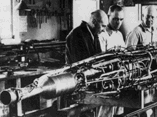Robert Goddard
Robert Goddard was a professor at Worcester Clark University in Massachusetts, USA. Goddard was fascinated by stories of Man going to the Moon. However, he realised that any vehicle used to go there could not use solid fuel as it could not generate sufficient power for a rocket to leave the atmosphere and defeat gravity.
The propulsion system would generate explosive power at the end of a rocket to propel it. Goddard concluded that any fuel would have to be liquid.
Goddard also faced the problem that the power generated by a rocket would have to be greater than the weight of the rocket itself – and it would need some power to spare. Goddard believed that if hydrogen could be piped into a combustion chamber sufficiently quickly and burnt with liquid oxygen, it would produce the desired force to propel a rocket to the Moon.
Goddard experimented with solid fuel rockets to refine his techniques. During World War One he also invented the bazooka which the US Army took up shortly before the end of the war in 1918.
In 1920, Goddard wrote a report about his rocket engine tests and sent it to the Smithsonian Institute. It was called “A method of reaching extreme altitude”. The New York Times got hold of a copy and severely criticised Goddard and his work. It claimed that Goddard lacked the knowledge given out to pupils in school on basic physics.
Rather than dishearten Goddard, the criticism spurred him into 20 years of intensive research. In 1926, Goddard launched his first prototype rocket, called Nell, at his aunt’s farm. Nell stood 10 feet tall. When its oxygen-gasoline fuel mix was ignited, nothing happened….at first. Then the ignition caught and Nell was launched at 60 mph and climbed to a modest 14 metres before falling back into a cabbage patch.
Goddard’s work attracted the attention of Charles Lindburgh – the first man to fly across the Atlantic. He introduced Goddard to Harvey Guggenheim – a millionaire financier who provided Goddard with sufficient funds to continue his research. Goddard moved to New Mexico and worked under the strictest of secrecy. Was this because of the potential military use of his invention ? Probably not. One newspaper referred to the success of Nell in 1926 as “Moon rocket misses target by 238,799 miles”. Why attract the attention of those who belittled your work ?
During the 1930’s, few American scientists wanted to talk to Goddard but he met with German engineers. The American military took no notice of his work. When World War Two broke out, Goddard was so worried by the attention the Germans had given to his work, that he contacted the American military and showed them film of his Nell’s rocket. The military was not interested. In 1944, the first V2’s hit London.
After the war, Goddard had the opportunity to examine a V2. He found that a lot of the work on the V2 copied his own work. The Nazis had taken his papers and read his 200 patent applications.

Goddard, far left, working on one of his engines
Goddard died of throat cancer in 1945. His work was taken up by American and, ironically, German scientists working for the Americans. In 1969, Neil Armstrong walked on the surface of the Moon after being taken out of the Earth’s atmosphere by Apollo 11. In 1969, the New York Times wrote a public apology to Goddard – the man who gave to science a liquid-fuel rocket.